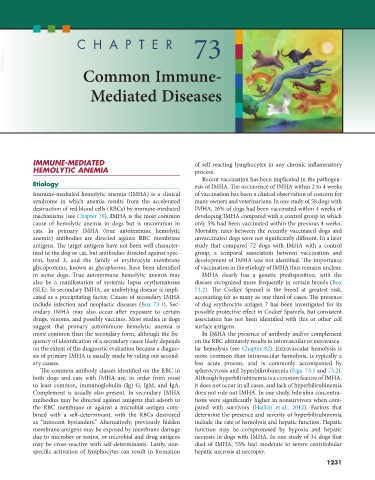Page 1259 - Small Animal Internal Medicine, 6th Edition
P. 1259
CHAPTER 73
VetBooks.ir
Common Immune-
Mediated Diseases
IMMUNE-MEDIATED of self-reacting lymphocytes in any chronic inflammatory
HEMOLYTIC ANEMIA process.
Recent vaccination has been implicated in the pathogen-
Etiology esis of IMHA. The occurrence of IMHA within 2 to 4 weeks
Immune-mediated hemolytic anemia (IMHA) is a clinical of vaccination has been a clinical observation of concern for
syndrome in which anemia results from the accelerated many owners and veterinarians. In one study of 58 dogs with
destruction of red blood cells (RBCs) by immune-mediated IMHA, 26% of dogs had been vaccinated within 4 weeks of
mechanisms (see Chapter 70). IMHA is the most common developing IMHA compared with a control group in which
cause of hemolytic anemia in dogs but is uncommon in only 5% had been vaccinated within the previous 4 weeks.
cats. In primary IMHA (true autoimmune hemolytic Mortality rates between the recently vaccinated dogs and
anemia) antibodies are directed against RBC membrane unvaccinated dogs were not significantly different. In a later
antigens. The target antigens have not been well character- study that compared 72 dogs with IMHA with a control
ized in the dog or cat, but antibodies directed against spec- group, a temporal association between vaccination and
trin, band 3, and the family of erythrocyte membrane development of IMHA was not identified. The importance
glycoproteins, known as glycophorins, have been identified of vaccination in the etiology of IMHA thus remains unclear.
in some dogs. True autoimmune hemolytic anemia may IMHA clearly has a genetic predisposition, with the
also be a manifestation of systemic lupus erythematosus disease recognized more frequently in certain breeds (Box
(SLE). In secondary IMHA, an underlying disease is impli- 73.2). The Cocker Spaniel is the breed at greatest risk,
cated as a precipitating factor. Causes of secondary IMHA accounting for as many as one third of cases. The presence
include infection and neoplastic diseases (Box 73.1). Sec- of dog erythrocyte antigen 7 has been investigated for its
ondary IMHA may also occur after exposure to certain possible protective effect in Cocker Spaniels, but consistent
drugs, venoms, and possibly vaccines. Most studies in dogs association has not been identified with this or other cell
suggest that primary autoimmune hemolytic anemia is surface antigens.
more common than the secondary form, although the fre- In IMHA the presence of antibody and/or complement
quency of identification of a secondary cause likely depends on the RBC ultimately results in intravascular or extravascu-
on the extent of the diagnostic evaluation because a diagno- lar hemolysis (see Chapter 82). Extravascular hemolysis is
sis of primary IMHA is usually made by ruling out second- more common than intravascular hemolysis, is typically a
ary causes. less acute process, and is commonly accompanied by
The common antibody classes identified on the RBC in spherocytosis and hyperbilirubinemia (Figs. 73.1 and 73.2).
both dogs and cats with IMHA are, in order from most Although hyperbilirubinemia is a common feature of IMHA,
to least common, immunoglobulin (Ig) G, IgM, and IgA. it does not occur in all cases, and lack of hyperbilirubinemia
Complement is usually also present. In secondary IMHA does not rule out IMHA. In one study, bilirubin concentra-
antibodies may be directed against antigens that adsorb to tions were significantly higher in nonsurvivors when com-
the RBC membrane or against a microbial antigen com- pared with survivors (Harkin et al., 2012). Factors that
bined with a self-determinant, with the RBCs destroyed determine the presence and severity of hyperbilirubinemia
as “innocent bystanders.” Alternatively, previously hidden include the rate of hemolysis and hepatic function. Hepatic
membrane antigens may be exposed by membrane damage function may be compromised by hypoxia and hepatic
due to microbes or toxins, or microbial and drug antigens necrosis in dogs with IMHA. In one study of 34 dogs that
may be cross-reactive with self-determinants. Lastly, non- died of IMHA, 53% had moderate to severe centrilobular
specific activation of lymphocytes can result in formation hepatic necrosis at necropsy.
1231

